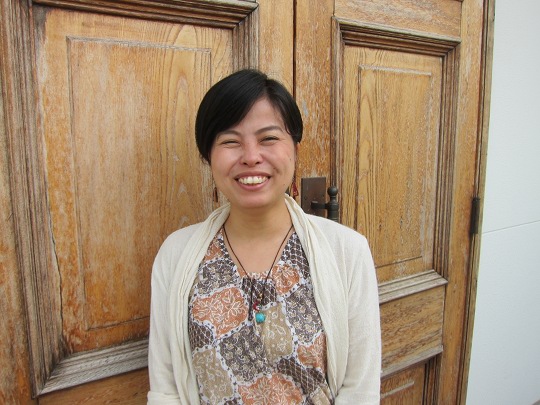
Ms. Maki Ariyoshi is a director and the secretary general of the Asian Women’s Empowerment Project (AWEP), a Kobe-based NPO conducting activities for the empowerment of Asian women. She has also worked as a volunteer in areas affected by the 2011 Great East Japan Earthquake and been involved in the revival of Shin-Nagata, Kobe City, an area heavily affected by the Great Hanshin-Awaji Earthquake. She says that at the root of all these activities lies her desire to “learn about the earthquakes precisely because she was not an earthquake victim, and build face-to-face connections between people.”
What does the AWEP do?
First, let’s take a look at what activities the AWEP does.
1. Fair trade activities
The AWEP began its activities in August 1994. At that time, an increasing number of Filipino women came to Japan to work as entertainers. Some of them got married with Japanese men and had children, but were forced to return home with their children because they could not contact their children’s fathers. They were in difficulty, without jobs or child support from their estranged partners.
Then, the AWEP launched the Asian Women’s Empowerment Project to help Asian women make and sell products to live independently in their home countries. Currently, the AWEP deals with fair trade organizations of the Philippines, Thailand, Nepal, and Indonesia, by selling at fair trade shops and general stores in Japan.
2. Study tours, seminars, and workshops
The AWEP organizes study tours to visit the makers of its products, in which not only its members, but also non-members interested in fair trade and women’s empowerment participate, to learn about the actual lives of Asian women. The AWEP also holds various events, including Asian cuisine workshops and seminars, to learn about Asia from foreign residents in Japan.
3. Telephone and face-to-face counseling for female foreign residents in Japan
The AWEP provides telephone and face-to-face consultation services about various issues for female foreign residents in Japan, every Wednesday, in English and Japanese.
4. Provision of information for foreign residents in Japan
The AWEP regularly sends the “Anshin (Peace of Mind) Press” newsletters to foreign residents in Japan whom the NPO has met through its activities. The newsletters provide information about various matters, such as child rearing and local events, in plain English and Japanese.
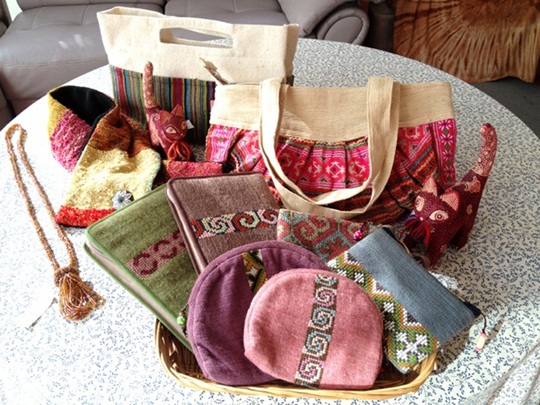 Back photo: Bags made with Philippine-made homespun cloth. They are provided by an organization established by single Filipino mothers raising their children whom they had by Japanese men. Front in photo: Pouches ornamented with traditional embroidery of a minority group living in Northern Thailand. They are made by an organization established with the aim of preventing female peasants from being forced to work in the sex industry.
Back photo: Bags made with Philippine-made homespun cloth. They are provided by an organization established by single Filipino mothers raising their children whom they had by Japanese men. Front in photo: Pouches ornamented with traditional embroidery of a minority group living in Northern Thailand. They are made by an organization established with the aim of preventing female peasants from being forced to work in the sex industry.
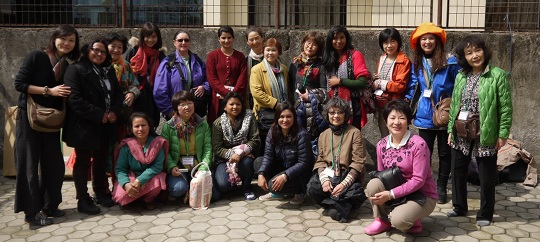 Photo: Nepal study tour staff members and participants. In March 2014, the AWEP organized a study tour to visit Nepal’s production group “Shakti Samuha.” The local NGO, based in Kathmandu, Nepal, was established by female victims of human trafficking. It has been providing health care and psychological support for female victims and their children, as well as promoting public awareness and preventive activities, and conducting activities to help female victims reintegrate into society and become independent. In 2011, the Nepalese NGO and the AWEP began to conduct fair trade business together, to create jobs making knit and Saori-ori textile products. The study tour provided an opportunity for local women to learn the Saori-ori weaving technique, and deepen exchanges with tour participants.
Photo: Nepal study tour staff members and participants. In March 2014, the AWEP organized a study tour to visit Nepal’s production group “Shakti Samuha.” The local NGO, based in Kathmandu, Nepal, was established by female victims of human trafficking. It has been providing health care and psychological support for female victims and their children, as well as promoting public awareness and preventive activities, and conducting activities to help female victims reintegrate into society and become independent. In 2011, the Nepalese NGO and the AWEP began to conduct fair trade business together, to create jobs making knit and Saori-ori textile products. The study tour provided an opportunity for local women to learn the Saori-ori weaving technique, and deepen exchanges with tour participants.
 Photo: Woven up shawls dried in the sun. Local shawl production facilities in Nepal not only lack laundry machines, but frequently suffer from power outage. Woven up shawls are dried in the sun, and pressed after electricity is restored. Using this method, it takes a very long time to make a finished shawl in Nepal.
Photo: Woven up shawls dried in the sun. Local shawl production facilities in Nepal not only lack laundry machines, but frequently suffer from power outage. Woven up shawls are dried in the sun, and pressed after electricity is restored. Using this method, it takes a very long time to make a finished shawl in Nepal.
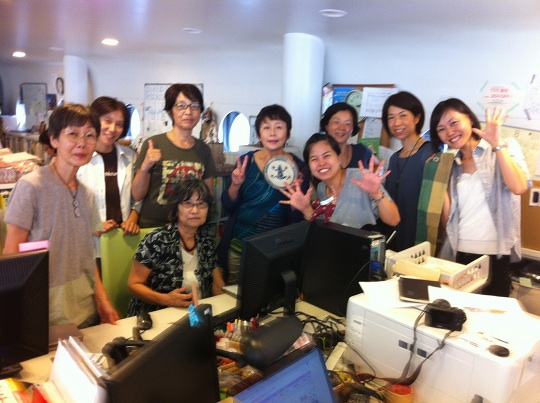 Photo: Members of the Kobe Nagata-based AWEP. Fourth right is Ms. Ariyoshi with her arms wide open in a cheerful way. Second left in the front row is Ms. Kazumi Moriki, a former head director and a director of the AWEP.
The Great Hanshin-Awaji Earthquake brought local problems to the surface
Photo: Members of the Kobe Nagata-based AWEP. Fourth right is Ms. Ariyoshi with her arms wide open in a cheerful way. Second left in the front row is Ms. Kazumi Moriki, a former head director and a director of the AWEP.
The Great Hanshin-Awaji Earthquake brought local problems to the surface
The Great Hanshin-Awaji Earthquake occurred six months after the establishment of the AWEP. AWEP members were also affected by the earthquake. In the confusion, Ms. Kazumi Moriki, the former AWEP head director, as well as other AWEP members at that time, started to gather information about the safety of foreign residents in Kobe. The AWEP conducted this and other activities, in cooperation with organizations from Osaka and Kyoto, to support foreigners.
According to the AWEP, it is difficult for foreign residents in Japan to obtain information about evacuation and support for the victims of disasters, and to find their place in refugee centers. Therefore, foreign residents affected by disasters tend to be isolated within their homes. The AWEP’s collection of information about the safety of foreign residents revealed that many Filipinos and Brazilians were isolated in many areas of Kobe.
After the earthquake, the AWEP started to do various kinds of activities to support foreign residents, such as giving them consultations and offering them local information, which helped them to achieve peace of mind. Those activities are still continuing.
What she can do precisely because she was not an earthquake victim
When the Great Hanshin-Awaji Earthquake struck, Ms. Ariyoshi was living in Okayama as a university student. At that time, she spent hours watching TV news about the earthquake at her friend’s house.
The earthquake caused little damage to my parents’ house in Kobe, although some things in the house crashed down to the floor. Immediately after the earthquake, when I called my parents, they said, “Don’t come back to Kobe. There’s nothing you can do here now.” I decided to stay in Okayama and concentrate on my studies, because I thought there was no point in returning home if I could do nothing in Kobe at that time.
Half a year after the earthquake, she returned to Kobe on summer vacation.
From the window of the train from Okayama to Kobe, I found that rubble had been cleared away and reconstruction works were in progress in Sannomiya and other areas of downtown Kobe. But my parents’ town didn’t seem to have been affected by the earthquake. After I returned to Okayama, I was frequently asked, “How were things in your hometown?” Those questions made me more and more guilty; I hated to answer, “There was no serious damage there.”
When talking about “earthquake-affected areas,” people tend to think that all such areas were severely affected, in the same way. In reality, however, the damage level varies from area to area, even within a town.
In the case of the Great Hanshin-Awaji Earthquake, six wards situated on the coastal side on the foot of Mt. Rokko in Kobe (Higashinada, Nada, Chuo, Hyogo, Nagata, and Suma wards) were especially heavily damaged. The house of Ms. Ariyoshi’s parents was only slightly damaged because of its location on the side of the mountain.
After Ms. Ariyoshi graduated from university, while still feeling a vague sense of guilt, she came back to Kobe to work for a general store, a job in which she had been interested since she was in university. Later, she started to work for another general store selling fair trade products.
At that time, Kobe had a shopping center named “Harbor Circus,” where many shops and stores which had been affected by the Great Hanshin-Awaji Earthquake each opened a 3.3m2 stall. While seeing those stalls, an idea came to Ms. Ariyoshi.
After coming back to Kobe, I started to think “I want to see what I’ve never seen and I want to know what I’ve never known before.” Through fair trade, I came to have a desire to learn more about not only foreign countries but also Japan and my local community.
What has been created as a result of the earthquakes
The office of the AWEP is within the Takatori Community Center (TCC) in Nagata Ward, Kobe City. Immediately after the Great Hanshin-Awaji Earthquake, the Takatori Rescue Base, the predecessor of the center, started to serve as an operational base of volunteers, etc. With foreign nationals accounting for 10% of the ward’s total population, the base put emphasis on supporting foreign residents. In 1999, the base was renamed the TCC, and the AWEP decided to continue to take part in the center.
Besides the AWEP, many other NPOs, NGOs, local groups, and churches are based in the TCC and work in cooperation with each other to build a community where all residents live together and understand each other, regardless of their nationality and culture. Now, the TCC promotes various activities which have been conducted since the earthquake and, by taking advantage of its experience, supports disaster victims around the world, including Japan.
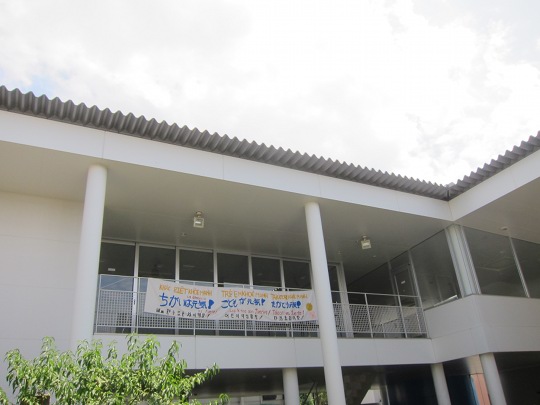 Photo: The TCC is within the grounds of Takatori Catholic Church. In the fire following the Great Hanshin-Awaji Earthquake, the old building of the church was completely destroyed and other structures in the grounds were damaged. Later, a temporary cathedral was constructed, designed by the famous Japanese architect Shigeru Ban, around which temporary office buildings were also built for various organizations working for earthquake victims. The current church building was re-constructed in 2007 and the TCC continues to work within the grounds of the church. The place which supported people helping each other at the out of the ordinary time following the earthquake has now become a base for people working to enrich their daily life, regardless of nationality or culture.
Photo: The TCC is within the grounds of Takatori Catholic Church. In the fire following the Great Hanshin-Awaji Earthquake, the old building of the church was completely destroyed and other structures in the grounds were damaged. Later, a temporary cathedral was constructed, designed by the famous Japanese architect Shigeru Ban, around which temporary office buildings were also built for various organizations working for earthquake victims. The current church building was re-constructed in 2007 and the TCC continues to work within the grounds of the church. The place which supported people helping each other at the out of the ordinary time following the earthquake has now become a base for people working to enrich their daily life, regardless of nationality or culture.
As well as working as an AWEP member, Ms. Ariyoshi has also served as a coordinator of an art project named the “Kizuna (bonding) Project” after the Great East Japan Earthquake in 2011. This art project began with interviewing people affected by the Great Hanshin-Awaji Earthquake. Based on the interviews, Ms. Tomomi Tamino, who proclaims herself a “name artist,” and the photographer Ms. Rie Inoue started working together to create works of art. Ms. Tamino writes poems by weaving in the names of interviewees. Now, they hold exhibitions of their work, as well as events to support the reconstruction of the affected areas, in various places around Japan.
One year after the Great East Japan Earthquake, I visited Miyagi Prefecture (one of the affected areas) for the art project, and then I visited the Tohoku region several times to conduct various volunteer activities. Maybe, through working as a volunteer in the areas affected by the Great East Japan Earthquake, I’ve been filling the hole in my heart I got at the time of the Great Hanshin-Awaji Earthquake, which I didn’t experience personally.
Ms. Ariyoshi and her fellow volunteers held a girls’ meeting in Kesennuma City, Miyagi Pref. to talk about the Great East Japan Earthquake. Surprisingly enough, many participants had a lingering sense of guilt because they had not been significantly affected by the great earthquake, just like Ms. Ariyoshi after the Great Hanshin-Awaji Earthquake.
I organized the girls’ meeting in cooperation with my fellow volunteers, considering that it’d be helpful to provide an opportunity for victims of the Great East Japan Earthquake to talk with those of the Great Hanshin-Awaji Earthquake, because it might be difficult for people affected by the same earthquake to openly discuss it.
In the meeting, I found an unexpectedly large number of participants say “I can’t tell others about difficulties facing me, because there are many people around me who have many more difficulties than I do.” In reality, however, they themselves had serious problems, for example, it was difficult for them to raise their children after the earthquake. At that time, I thought various forms of support were necessary to help each and every earthquake victim.
I haven’t had direct experience of large earthquakes. So, I’d like to continue offering indirect support this way.
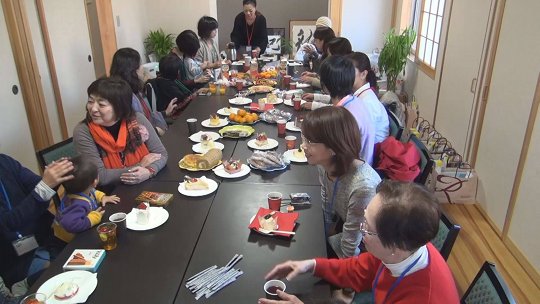 Photo: The “1st Tohoku & Kobe Girls’ Meeting in Kesennuma” held in Nov. 2013, where earthquake victims of Kesennuma and Kobe had an informal discussion
Photo: The “1st Tohoku & Kobe Girls’ Meeting in Kesennuma” held in Nov. 2013, where earthquake victims of Kesennuma and Kobe had an informal discussion
In this interview, Ms. Ariyoshi often used words describing “a connection between people.” She says: “The important thing is developing a strong bond between people, and keeping the memories of the disasters from fading away.”
The Great Hanshin-Awaji Earthquake left a deep scar in Kobe. However, after the earthquake, a spirit of mutual assistance in search for hope was born from that scar, and spread widely.
Perhaps what makes Kobe, a city remarkably revived from the devastation two decades ago, look more brilliant is “bonds between people from the scar left by the earthquake.”
(Interviewed and written by Aya Hemmendinger)
This article was created with the cooperation of
greenz.jp.
![]() an international activist
an international activist JP | EN
JP | EN JP | EN
JP | EN





